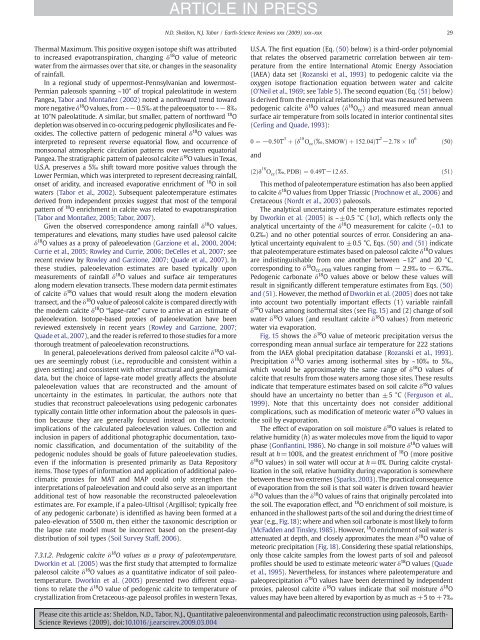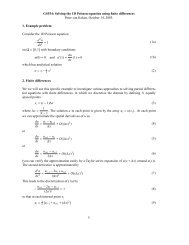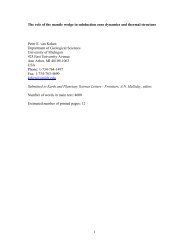Quantitative paleoenvironmental and paleoclimatic reconstruction ...
Quantitative paleoenvironmental and paleoclimatic reconstruction ...
Quantitative paleoenvironmental and paleoclimatic reconstruction ...
You also want an ePaper? Increase the reach of your titles
YUMPU automatically turns print PDFs into web optimized ePapers that Google loves.
ARTICLE IN PRESS<br />
N.D. Sheldon, N.J. Tabor / Earth-Science Reviews xxx (2009) xxx–xxx<br />
29<br />
Thermal Maximum. This positive oxygen isotope shift was attributed<br />
to increased evapotranspiration, changing δ 18 O value of meteoric<br />
water from the airmasses over that site, or changes in the seasonality<br />
of rainfall.<br />
In a regional study of uppermost-Pennsylvanian <strong>and</strong> lowermost-<br />
Permian paleosols spanning ~10° of tropical paleolatitude in western<br />
Pangea, Tabor <strong>and</strong> Montañez (2002) noted a northward trend toward<br />
more negative δ 18 O values, from ~− 0.5‰ at the paleoequator to ~− 8‰<br />
at 10°N paleolatitude. A similar, but smaller, pattern of northward 18 O<br />
depletion was observed in co-occuring pedogenic phyllosilicates <strong>and</strong> Feoxides.<br />
The collective pattern of pedogenic mineral δ 18 O values was<br />
interpreted to represent reverse equatorial flow, <strong>and</strong> occurrence of<br />
monsoonal atmospheric circulation patterns over western equatorial<br />
Pangea. The stratigraphic pattern of paleosol calcite δ 18 O values in Texas,<br />
U.S.A. preserves a 5‰ shift toward more positive values through the<br />
Lower Permian, which was interpreted to represent decreasing rainfall,<br />
onset of aridity, <strong>and</strong> increased evaporative enrichment of 18 Oinsoil<br />
waters (Tabor et al., 2002). Subsequent paleotemperature estimates<br />
derived from independent proxies suggest that most of the temporal<br />
pattern of 18 O enrichment in calcite was related to evapotranspiration<br />
(Tabor <strong>and</strong> Montañez, 2005; Tabor, 2007).<br />
Given the observed correspondence among rainfall δ 18 O values,<br />
temperatures <strong>and</strong> elevations, many studies have used paleosol calcite<br />
δ 18 O values as a proxy of paleoelevation (Garzione et al., 2000, 2004;<br />
Currie et al., 2005; Rowley <strong>and</strong> Currie, 2006; DeCelles et al., 2007; see<br />
recent review by Rowley <strong>and</strong> Garzione, 2007; Quade et al., 2007). In<br />
these studies, paleoelevation estimates are based typically upon<br />
measurements of rainfall δ 18 O values <strong>and</strong> surface air temperatures<br />
along modern elevation transects. These modern data permit estimates<br />
of calcite δ 18 O values that would result along the modern elevation<br />
transect, <strong>and</strong> the δ 18 O value of paleosol calcite is compared directly with<br />
the modern calcite δ 18 O “lapse-rate” curve to arrive at an estimate of<br />
paleoelevation. Isotope-based proxies of paleoelevation have been<br />
reviewed extensively in recent years (Rowley <strong>and</strong> Garzione, 2007;<br />
Quade et al., 2007), <strong>and</strong> the reader is referred to those studies for a more<br />
thorough treatment of paleoelevation <strong>reconstruction</strong>s.<br />
In general, paleoelevations derived from paleosol calcite δ 18 O values<br />
are seemingly robust (i.e., reproducible <strong>and</strong> consistent within a<br />
given setting) <strong>and</strong> consistent with other structural <strong>and</strong> geodynamical<br />
data, but the choice of lapse-rate model greatly affects the absolute<br />
paleoelevation values that are reconstructed <strong>and</strong> the amount of<br />
uncertainty in the estimates. In particular, the authors note that<br />
studies that reconstruct paleoelevations using pedogenic carbonates<br />
typically contain little other information about the paleosols in question<br />
because they are generally focused instead on the tectonic<br />
implications of the calculated paleoelevation values. Collection <strong>and</strong><br />
inclusion in papers of additional photographic documentation, taxonomic<br />
classification, <strong>and</strong> documentation of the suitability of the<br />
pedogenic nodules should be goals of future paleoelevation studies,<br />
even if the information is presented primarily as Data Repository<br />
items. Those types of information <strong>and</strong> application of additional <strong>paleoclimatic</strong><br />
proxies for MAT <strong>and</strong> MAP could only strengthen the<br />
interpretations of paleoelevation <strong>and</strong> could also serve as an important<br />
additional test of how reasonable the reconstructed paleoelevation<br />
estimates are. For example, if a paleo-Ultisol (Argillisol; typically free<br />
of any pedogenic carbonate) is identified as having been formed at a<br />
paleo-elevation of 5500 m, then either the taxonomic description or<br />
the lapse rate model must be incorrect based on the present-day<br />
distribution of soil types (Soil Survey Staff, 2006).<br />
7.3.1.2. Pedogenic calcite δ 18 O values as a proxy of paleotemperature.<br />
Dworkin et al. (2005) was the first study that attempted to formalize<br />
paleosol calcite δ 18 O values as a quantitative indicator of soil paleotemperature.<br />
Dworkin et al. (2005) presented two different equations<br />
to relate the δ 18 O value of pedogenic calcite to temperature of<br />
crystallization from Cretaceous-age paleosol profiles in western Texas,<br />
U.S.A. The first equation (Eq. (50) below) is a third-order polynomial<br />
that relates the observed parametric correlation between air temperature<br />
from the entire International Atomic Energy Association<br />
(IAEA) data set (Rozanski et al., 1993) to pedogenic calcite via the<br />
oxygen isotope fractionation equation between water <strong>and</strong> calcite<br />
(O'Neil et al., 1969; see Table 5). The second equation (Eq. (51) below)<br />
is derived from the empirical relationship that was measured between<br />
pedogenic calcite δ 18 O values (δ 18 O cc ) <strong>and</strong> measured mean annual<br />
surface air temperature from soils located in interior continental sites<br />
(Cerling <strong>and</strong> Quade, 1993):<br />
0 ¼ −0:50T 3 þðδ 18 O cc ð‰; SMOWÞþ152:04ÞT 2 −2:78 10 6 ð50Þ<br />
<strong>and</strong><br />
ð2Þδ 18 O cc ð‰; PDBÞ ¼0:49T−12:65:<br />
ð51Þ<br />
This method of paleotemperature estimation has also been applied<br />
to calcite δ 18 O values from Upper Triassic (Prochnow et al., 2006) <strong>and</strong><br />
Cretaceous (Nordt et al., 2003) paleosols.<br />
The analytical uncertainty of the temperature estimates reported<br />
by Dworkin et al. (2005) is ~±0.5 °C (1σ), which reflects only the<br />
analytical uncertainty of the δ 18 O measurement for calcite (~0.1 to<br />
0.2‰) <strong>and</strong> no other potential sources of error. Considering an analytical<br />
uncertainty equivalent to ±0.5 °C, Eqs. (50) <strong>and</strong> (51) indicate<br />
that paleotemperature estimates based on paleosol calcite δ 18 O values<br />
are indistinguishable from one another between ~12° <strong>and</strong> 20 °C,<br />
corresponding to δ 18 O cc-PDB values ranging from − 2.9‰ to − 6.7‰.<br />
Pedogenic carbonate δ 18 O values above or below these values will<br />
result in significantly different temperature estimates from Eqs. (50)<br />
<strong>and</strong> (51). However, the method of Dworkin et al. (2005) does not take<br />
into account two potentially important effects (1) variable rainfall<br />
δ 18 O values among isothermal sites (see Fig. 15) <strong>and</strong> (2) change of soil<br />
water δ 18 O values (<strong>and</strong> resultant calcite δ 18 O values) from meteoric<br />
water via evaporation.<br />
Fig. 15 shows the δ 18 O value of meteoric precipitation versus the<br />
corresponding mean annual surface air temperature for 222 stations<br />
from the IAEA global precipitation database (Rozanski et al., 1993).<br />
Precipitation δ 18 O varies among isothermal sites by ~10‰ to 5‰,<br />
which would be approximately the same range of δ 18 O values of<br />
calcite that results from those waters among those sites. These results<br />
indicate that temperature estimates based on soil calcite δ 18 O values<br />
should have an uncertainty no better than ±5 °C (Ferguson et al.,<br />
1999). Note that this uncertainty does not consider additional<br />
complications, such as modification of meteoric water δ 18 O values in<br />
the soil by evaporation.<br />
The effect of evaporation on soil moisture δ 18 O values is related to<br />
relative humidity (h) as water molecules move from the liquid to vapor<br />
phase (Gonfiantini, 1986). No change in soil moisture δ 18 O values will<br />
result at h=100%, <strong>and</strong> the greatest enrichment of 18 O (more positive<br />
δ 18 O values) in soil water will occur at h=0%. During calcite crystallization<br />
in the soil, relative humidity during evaporation is somewhere<br />
between these two extremes (Sparks, 2003). The practical consequence<br />
of evaporation from the soil is that soil water is driven toward heavier<br />
δ 18 O values than the δ 18 O values of rains that originally percolated into<br />
the soil. The evaporation effect, <strong>and</strong> 18 O enrichment of soil moisture, is<br />
enhanced in the shallowest parts of the soil <strong>and</strong> during the driest time of<br />
year (e.g., Fig. 18); where <strong>and</strong> when soil carbonate is most likely to form<br />
(McFadden <strong>and</strong> Tinsley, 1985). However, 18 O enrichment of soil water is<br />
attenuated at depth, <strong>and</strong> closely approximates the mean δ 18 O value of<br />
meteoric precipitation (Fig. 18). Considering these spatial relationships,<br />
only those calcite samples from the lowest parts of soil <strong>and</strong> paleosol<br />
profiles should be used to estimate meteoric water δ 18 Ovalues(Quade<br />
et al., 1995). Nevertheless, for instances where paleotemperature <strong>and</strong><br />
paleoprecipitation δ 18 O values have been determined by independent<br />
proxies, paleosol calcite δ 18 O values indicate that soil moisture δ 18 O<br />
values may have been altered by evaportion by as much as +5 to +7‰<br />
Please cite this article as: Sheldon, N.D., Tabor, N.J., <strong>Quantitative</strong> <strong>paleoenvironmental</strong> <strong>and</strong> <strong>paleoclimatic</strong> <strong>reconstruction</strong> using paleosols, Earth-<br />
Science Reviews (2009), doi:10.1016/j.earscirev.2009.03.004















